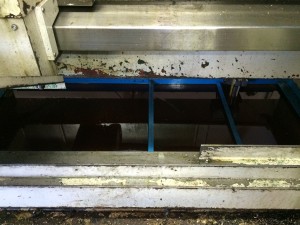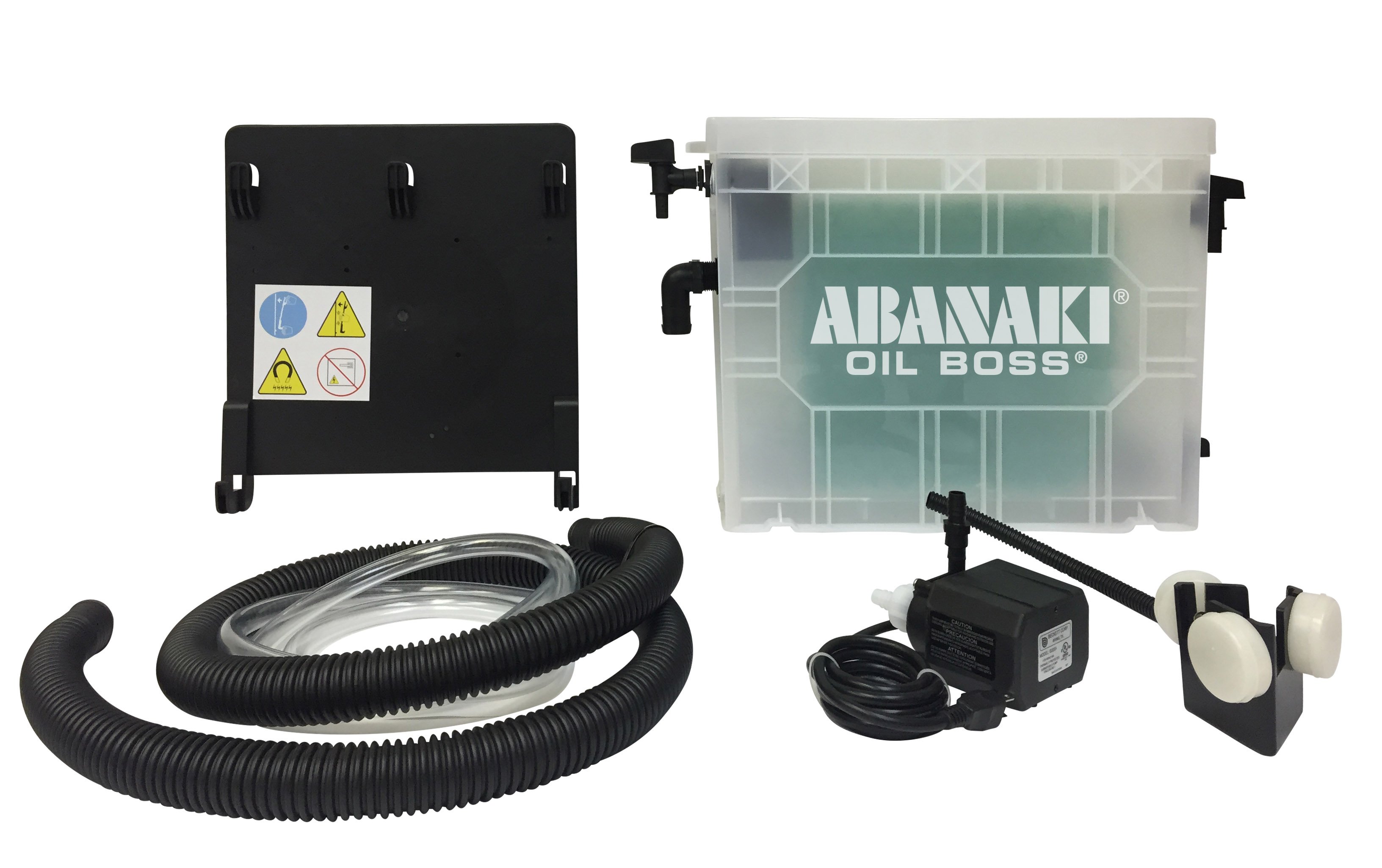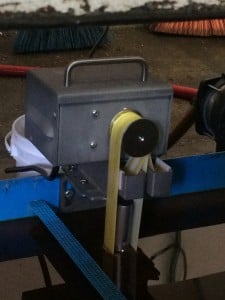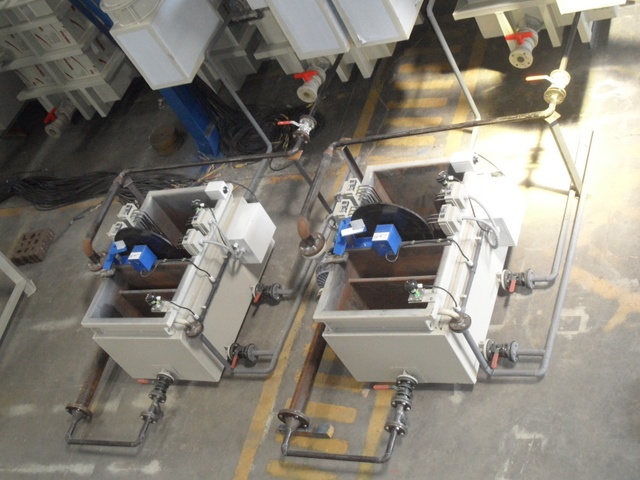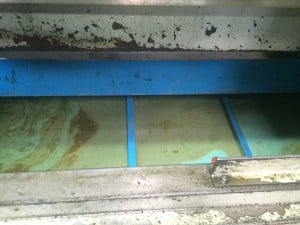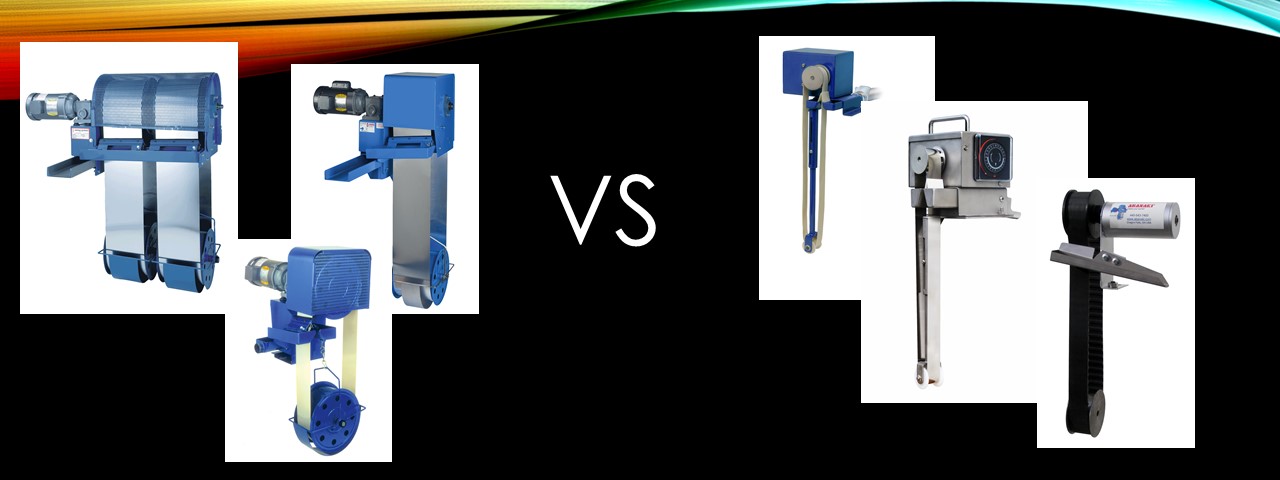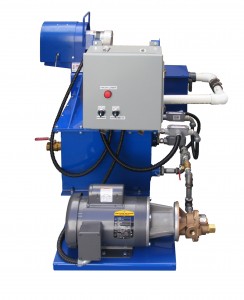How to Triple Machine Coolant Life With Oil Skimmers | Abanaki
Topics: oil skimmers, belt skimmer, oil concentrator, tote-it, belt oil skimmer
Although designs vary, all oil skimmers rely on specific gravity, surface tension and a moving medium to remove floating oil from a fluid’s surface.
Topics: oil skimmers, belt skimmer, belt materials, belt oil skimmer
Tramp Oil Collection: Coalescers vs Oil Skimmers | Abanaki
Multiple options exist for the collection of tramp oils. Two of the most common are oil skimmers and coalescers. Both offer unique advantages and disadvantages in certain applications.
Coalescers
Coalescers focus on collecting oil into larger droplets. Using a filter medium, the oil is gathered into one place and combines into a larger oil droplet, heightening the differing densities of oil and water. The oil then floats to the top of the coalescer, allowing removal by other means.
Coalescers have an advantage in specific coolant-related applications. Coalescers cover a bigger collection area than oil skimmers, speeding recovery and reducing need for moving the oil collection device.
Unlike oil skimmers, coalescers have no need for a collection container, preventing the potential for spillage. Abanaki's Oil Boss can also be hung from a metallic surface, preventing the floor space footprint of other coalescers and oil skimmers.
Oil Skimmers
Oil skimmers focus on removing tramp oils using oleophilic belts. These belts attract the tramp oils and drag them up to a trough where they are scraped off, removing them from the water or coolant. Different belts have different specialties, such as steel belts being suited for LNAPLs and tramp oils.
Oil skimmers have an advantage in more varied conditions. Able to be used in high temperature applications where plastic coalescers might face pump failures, oil skimmers can withstand more extreme environments.
In addition, oil skimmers do not have to worry about pumps clogged by shavings or solid byproducts like coalescers might. Dirty oil can also go back into the sump in coalescers, while oil is completely removed by a oil skimmer. Oil skimmers also have more applications than coalescers, such as environmental remediation.
For more information about our line of coalescers and oil skimmers, take a look at our product catalog using the button below, or contact us via phone at (440) 543-7400 or via e-mail at skimmers@abanaki.com.
Topics: oil skimmers, belt skimmer, belt materials, coolescer, belt oil skimmer, coalescers
Selecting the right belt material is just as important as selecting the right skimmer. Choose the wrong belt and the skimmer will not work correctly. Things like pH, temperature, and oil type are crucial considerations.
Purpose of Oil Skimmer Belts
Selecting the right belt material is just as important as selecting the right skimmer. You might choose the right skimmer but the wrong belt type and the skimmer will not work correctly to solve your oil in water problem. It is crucial that things like pH, temperature, and oil type are considered when selecting a skimmer AND a belt type.
A belt is to a skimmer like wheels to a car’s chassis: although the latter is the most identifiable part, it needs the former to actually run. Just like tires, belts are not one size fits all. Just as there are snow tires, street tires, year-round tires, and more, so too are there a variety of belt materials. So, what purpose does each serve?
Different Kind of Oil Skimmer Belt Materials
There is a great deal of variance in applications where belt oil skimmers are present. Figuring out what would be the best belt material for your belt skimmer will depend on a few factors. For the most part, belts pick up the oil in the same fashion so the big difference is finding what will give you the longest operating life.
Steel Belts
Steel belts are the standard for many applications. Their durability, corrosion resistance, and strong oleophilic tendencies make the material effective in most scenarios. The lower price and ease of welding also reduce costs. The biggest caveat is their ineffectiveness when confronted with rust inhibitors in wash water. Steel belts are also ineffective in most applications where Petro-Xtractors are used.
Elastomer Belts
Elastomer belts are an alternative to steel belts that perform well in a multitude of situations. These belts can handle some of the harshest, most abrasive conditions a skimmer can be placed in and are fully compatible with the Petro-Xtractor. Still, steel belts will not stretch when exposed to UV rays over a long period of time.
Polymer (Poly) Belts
Polymer belts, commonly shortened to poly belts, are meant for higher temperatures and conditions where UV exposure and rust inhibitors are an issue. The textured nature of the poly belts causes more oil than usual to be picked up. This option tends to be pricier, but works like a charm in intense functions.
Fuzzy Belts
This video demonstrates how choosing the right belt material makes all of the difference. The Fuzzy belt does a better job at picking up the hydrocarbon than the standard belt on the right.
LFO belts, commonly referred to as Fuzzy belts, are a proprietary skimmer belt exclusive to Abanaki. This material specializes in the rapid removal of light, non-viscous hydrocarbons from water. If your problem is an oil like gasoline, the Fuzzy belt will remove it much more efficiently than any other belt in normal conditions. The Fuzzy belts are also extremely resistant to stretching.
XP Polymer (Poly) Belts
XP polymer belts, commonly shortened to XP poly belts, are very similar to poly belts. The key difference comes in its texture and temperature resistance. The XP poly belt is better able to handle high temperatures, maxing out at 180ºF. The belt also has a smooth texture rather than the ridged design of the standard poly belt. Although this change means the XP poly belt will not pick up oil as quickly, the belt will function better than the standard poly belt in conditions that would wear away the ridged design.
More information can be found in the Abanaki Oil Skimmer Factbook or Abanaki Belt Selection Guidebook. It is best to call (440-543-7400) with details of the application and ask your Abanaki representative what will work best with your belt skimmer.
Topics: oil skimmers, belt skimmer, belt materials, belt oil skimmer
Advantages of Using an Oil Skimmer in the Machining Industry
Companies look for effective ways to remove oil from water or coolant to reduce costs and the liability of proper disposal. Another reason for removing the oil is a better work environment. Letting oil remain in the coolant tank allows anaerobic bacteria to grow. Anaerobic bacteria break down the components of coolant, causing it to need changing more frequently. Oil-laden coolant with a high anaerobic bacteria content has two other drawbacks as well. The first drawback is an unpleasant odor caused by the bacteria. The second drawback the smoke generated from the oil-laden coolant coming in contact with the operating cutting tool. One of the easiest ways to remove hydrocarbons from water or coolant is by using an oil skimmer. It is a low maintenance, easy to use tool for removing oil from water or coolant.
The use of an oil skimmer holds many benefits including:
Reduction of Disposal Costs: The cost of disposing oil laden coolant is more expensive than the disposing of oil.
Recycling Opportunities: In some instances, companies may be able to re-use the skimmed oil elsewhere or sell it for recycling, choosing to keep their part of the world cleaner.
Extend Coolant Life: Having oil free coolant can also extend its usefulness and effectiveness, reducing the expense on maintenance and coolant replacement.
Esthetic Benefits: Removing the oil from a machine coolant tank will cut down on the amount of smoke generated from the cutting tool coming into contact with oil laden coolant thereby creating a visibly cleaner workplace.
Extend Tool Life: Removing floating surface oils while aerating and refreshing coolant will extend tool life as well.
Avoid EPA Violations: Many machining and metal working shops turn to aqueous parts cleaning because of limits imposed by the EPA on the discharge of emissions and wastes.
Hygienic Benefits: Keeping coolant oxygenated and oil-free reduces the “rotten egg” odor and bacterial levels are lowered resulting in a cleaner work environment.
Abanaki Corporation manufactures a wide variety of oil skimmers to meet any size application. From a small coolant tank in a CNC lathe to a scale pit in a steel mill, Abanaki Corporation can supply a skimmer to do the job. We manufacture skimmers that can remove from 1 gallon per hour to 200 gallons per hour. We offer turnkey systems with a variety of motors, heat options, stands, and oil concentrators. Our skimmers are used on parts washers, in car washes, wells, steel mills, and any other industry where hydrocarbons need to be removed.
To find out which of our skimmers would suit your application the best, please contact our experts at 440-543-7400, or click the button below to get our Oil Skimming Factbook.
Topics: coolant, tube oil skimmer, oil skimmer, tubetastic, tote-it, coolant skimmer, mighty mini, belt oil skimmer, dirty coolant, disk skimmer, oil boss, oil boss oil skimmer, mighty disk
It is a common question asked every day by people in all fields of industry. Machine shops, steel mills, industrial manufacturers, and many others are faced with the problem of removing oils from coolants and wastewater on an everyday basis. They are faced with high disposal and maintenance costs. Some manufacturers are charged extreme amounts to have their contaminated water treated properly by their local water treatment facility.
Companies look for effective ways to remove oil from water or coolant to reduce costs and the liability of proper disposal. Another reason for removing the oil is a better work environment. Letting oil remain in the coolant tank allows anaerobic bacteria to grow. Anaerobic bacteria break down the components of coolant, causing it to need changing more frequently. Oil-laden coolant with a high anaerobic bacteria content has two other drawbacks as well. The first drawback is an unpleasant odor caused by the bacteria. The second drawback the smoke generated from the oil-laden coolant coming in contact with the operating cutting tool. One of the easiest ways to remove hydrocarbons from water or coolant is by using a belt oil skimmer. It is a low maintenance, easy to use tool for removing oil from water or coolant.
Belt oil skimmers work because of the differences in specific gravity between oil and water. Water has a specific gravity of one. Most oils have a specific gravity of less than one. Because of these differences, oil floats to the top of the water where it can be removed. A belt oil skimmer uses oil oleophilic material, (usually made of stainless steel or plastic), in the form of a belt to break the surface tension of the water to attract
and collect the floating oil. The belt passes through a set of wiper blades via a motorized head pulley where the oil is wiped off both sides of the belt. The oil then flows through the skimmer troughs and into a proper disposal container. Because the belt materials used do not attract water, very little coolant or water is picked up.
Some of the advantages of using a belt oil skimmer over other methods to remove oil are the lower initial cost compared to coalescers and other filtration systems, low maintenance, no filters to change, and no mess involved as with absorbent booms or pads. With an oil skimmer, virtually the only required maintenance is replacing a belt and wiper blade set as needed. Next, Abanaki skimmers require very little operating space, usually with no modification to the tank. Finally, our oil skimmers have pick-up rates of up to 200 gph with minimal water or coolant content. Other forms of oil removal cannot perform as well.
There are many instances where companies have turned their disposal costs into income. By using an Abanaki oil skimmer to remove oil from the coolant, one company was able to sell its used oil to be recycled instead of being charged to have the oil-contaminated coolant disposed of. Another money saving benefit was an extended coolant life resulting in lower coolant and maintenance costs. Because of this, the Abanaki oil skimmer paid for itself in a short period of time.
Abanaki Corporation manufactures a wide variety of oil skimmers to meet any size application. From a small coolant tank in a CNC lathe to a scale pit in a steel mill, Abanaki Corporation can supply a skimmer to do the job. We manufacture skimmers that can remove from 1 gallon per hour to 200 gallons per hour. We offer turnkey systems with a variety of motors, heat options, stands, and oil concentrators. Our skimmers are used on parts washers, in car washes, wells, steel mills, and any other industry where hydrocarbons need to be removed.
To find out which of our skimmers would suit your application the best, please contact our experts at 440-543-7400, or click the button below to get our Coolant Guide Book.
Topics: coolant, tube oil skimmer, oil skimmer, tubetastic, tote-it, coolant skimmer, mighty mini, belt oil skimmer, dirty coolant, disk skimmer, oil boss, oil boss oil skimmer, mighty disk
How to Select the Right Coolant Oil Skimmer for the Machine Shop
The use of an oil skimmer in the machine shop setting holds many benefits. Removing the oil from a machine coolant tank will initiate some esthetic benefits such as cutting down on the amount of smoke generated from the cutting tool coming into contact with oil laden coolant.
When a machine is shut down for the weekend, oil has a chance to come to the surface of the coolant tank. Bacteria that are living in the coolant tank use up the dissolved oxygen in the coolant mix, a process that is sped up by having a layer of oil on the surface. This allows odor causing anaerobic bacteria to thrive, giving off that familiar “rotten egg” smell.
Contrary to popular belief the common types of bacteria found in metalworking fluids do not cause dermatitis. However, if the skin is broken, bacteria that normally inhabit the skin may enter and cause infection. The presence of phosphates and carbonates that increase alkalinity in the coolant, however, can cause dermatitis. These impurities are found in the water being used in the coolant mix.
Separating the oil from the coolant will also help reduce disposal costs. The cost of disposing of oil laden coolant is more expensive than disposing of oil. In fact, in some instances, companies may be able to re-use the oil elsewhere or sell it for recycling. Having oil free coolant can also extend its usefulness and effectiveness, reducing the expense on maintenance and coolant replacement. As the research on the different types of oil skimmers begins, a person will find that there are a variety of skimmers available to them. The most common types are the belt, disk, and tube skimmers. Each type of coolant skimmer has its advantages and disadvantages.
There are also many factors that need to be considered when choosing the correct type of oil skimmer to fit the appropriate application. Factors such as water level fluctuation, water temperature, pH level, the use of rust inhibitors, the amount of oil to be skimmed, quality, and cost, must all be considered when selecting an oil skimmer.
The use of rust inhibitors, high temperatures, and variable pH levels can affect the skimmers ability to pick up oil. Most skimmer manufacturers use a variety of materials for the skimming medium such as plastic, stainless steel, or poly blends to match the solution in which they will be used.
There are a multitude of oil skimmers on the market today. One of the most important things to be considered is the quality of the unit to be purchased. Points of interest should include construction materials, motor design, and the type of warranty that is offered. Is the skimmer housing made of metal or plastic? Is the motor fan-cooled? Does the motor use needle bearings or bronze bearings? How long does the warranty last and what does it cover? Most oil skimmers will perform as advertised, but remember the old adage that “you get what you pay for”.
To find out which of our skimmers would suit your application the best, please contact our experts at 440-543-7400, or click the button below to get our Coolant Guide Book.
Topics: coolant, tube oil skimmer, oil skimmer, tubetastic, tote-it, mighty mini, belt oil skimmer, disk skimmer, oil boss oil skimmer, mighty disk
Pro Tips: Bigger Isn’t Always Better and Smaller Isn’t Always Cheaper
Choosing a skimmer based on size speculation can be a costly mistake. Buying the smallest skimmer available because it is the cheapest or purchasing the biggest skimmer because you think it will work faster will not lead to successful skimming results.
Topics: oil removal, belt material, belt oil skimmer, water temparature, viscosity
Topics: oil removal, tote-it, belt oil skimmer
Topics: oil skimming, oil skimmer, belt oil skimmer


